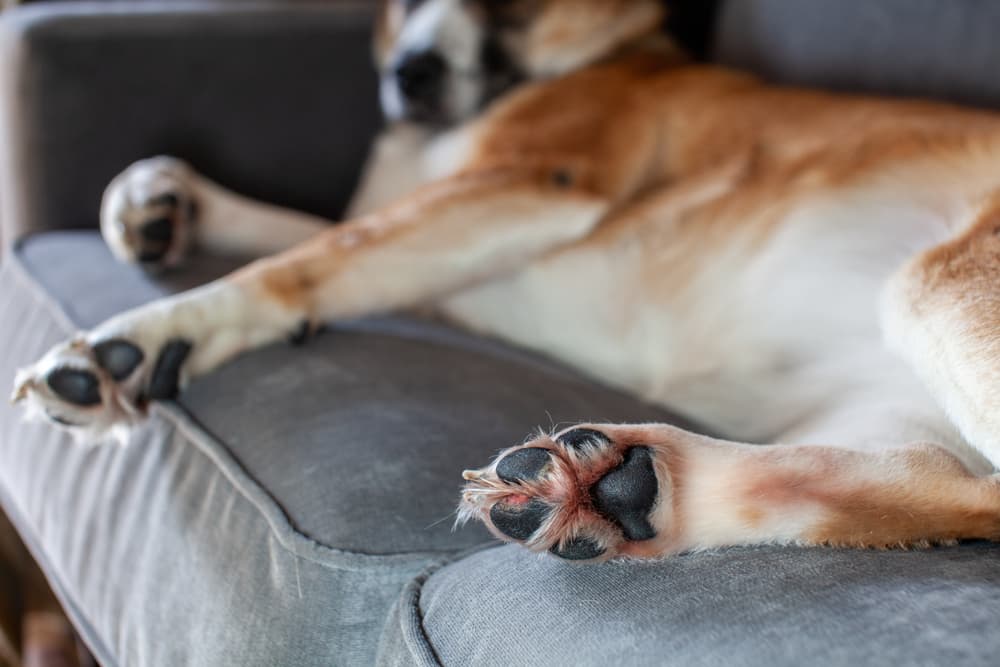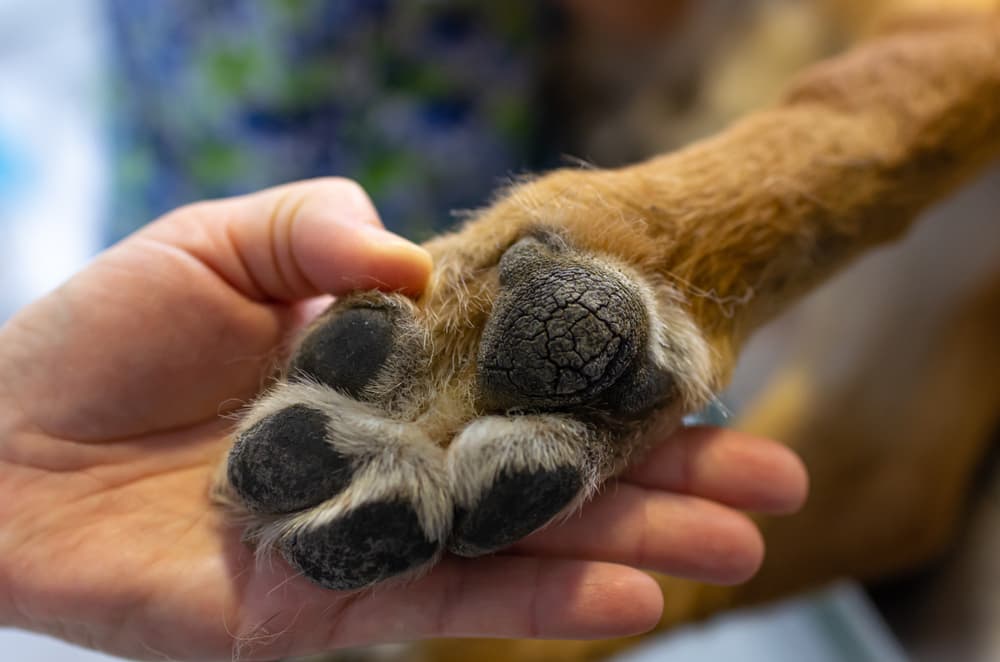Dog Paw Hyperkeratosis

Overview
- Hyperkeratosis happens most often on a dog's paw or nose.
- It is an abnormal overgrowth of keratin that leaves dry, flaky, cracked crusts on a dog's skin.
- Causes may be unknown or related to an underlying medical condition.
- Most forms of paw hyperkeratosis are harmless, but they could cause pain or limping.
- Treatment will depend on the cause and if your dog is experiencing discomfort.
Does your senior dog have a crusty nose or thickened paw pads? He might have dog paw hyperkeratosis or dog nose hyperkeratosis—a common but typically harmless condition in middle aged and senior dogs.
Younger dogs can also experience hyperkeratosis, although this is less common. In some cases, this condition can occur as a result of other skin problems, so it’s important to know what to look for when evaluating those crusty spots on your dog.
What is Hyperkeratosis?
All featured products are chosen at the discretion of the author. However, Great Pet Care may make a small affiliate commission if you click through and make a purchase.
In both dogs and humans, the outer layer of skin contains a protein called keratin, which provides protection for the underlying layers of skin. The body may naturally produce more keratin in response to inflammation or pressure—such as when you develop a callus from your shoe rubbing against your foot.
Hyperkeratosis is an abnormal overgrowth of keratin which may occur due to an underlying medical problem or for no apparent reason at all. This often appears as raised, rough, thickened crusts of skin or hairy, tentacle-like growths on the nose, paws, and ears of our canine companions.
What Causes Dog Paw Hyperkeratosis?

In middle age and senior dogs, dog paw hyperkeratosis is often idiopathic, which means we don’t know exactly what causes it. It’s likely that there is some genetic component to this condition as some breeds, such as Cocker Spaniels, appear to be predisposed.
Most affected dogs will have hyperkeratosis for the remainder of their lives. In most of these cases, hyperkeratosis is benign and does not affect the dog’s longevity or quality of life. However, hyperkeratosis growths on the paws can sometimes affect the dog’s gait or cause pain, so treatment may be necessary to manage this condition.
Hyperkeratosis can also occur as a result of other medical conditions, such as:
- Canine Distemper Virus
- Pemphigus Foliaceus
- Zinc-responsive Dermatosis
- Congenital disorders of cornification or keratinization
- Papilloma virus infection
- Hepatocutaneous syndrome
- Ichthyosis
These conditions are more complex, but treatment for the underlying condition can improve or resolve hyperkeratosis in some cases.
Symptoms of Paw Hyperkeratosis in Dogs
Hyperkeratosis causes a characteristic overgrowth of keratin fronds that can give affected areas a crusty, horned, or hairy appearance.
These changes usually occur on the nose, paws, or ears. Occasionally, hyperkeratosis can also develop on the elbows or hips in large breed dogs.
Other symptoms of hyperkeratosis included:
- Depigmentation (loss of skin color) on the affected area
- Cracks or fissures in the affected areas
- Secondary infections
- Ulceration of the affected areas
- Limping on affected paws
If your dog exhibits symptoms of dog paw hyperkeratosis or other forms of hyperkeratosis, it’s important to see your veterinarian to have the changes evaluated. Although this condition tends to be relatively benign, other causes of hyperkeratosis require prompt and aggressive treatment.
Diagnosing Dog Paw Hyperkeratosis

Hyperkeratosis has a characteristic appearance and distribution pattern, which means it can often be diagnosed on physical examination alone. In middle aged and older dogs with no other symptoms, this may be all that is needed to reach a diagnosis.
However, if your dog’s hyperkeratosis is accompanied by other symptoms or skin problems, your veterinarian may recommend additional testing, such as:
Biopsy and histopathology. Your veterinarian may recommend taking a punch biopsy of one or several affected areas and submitting these samples to a lab for analysis by a pathologist. This can help determine the underlying cause of the hyperkeratosis. In some cases, submitting the samples to a pathologist who specializes in dermatology may be necessary.
Skin cytology. Regardless of the underlying cause of your dog’s hyperkeratosis, your veterinarian may also recommend taking samples from the affected skin to identify any underlying infection. Areas of hyperkeratosis may be more prone to infection than healthy skin, particularly if cracks or fissures are present.
Since hyperkeratosis can be the result of other medical conditions, consider having a pet health insurance policy for your dog. Spot Pet Insurance offers policy options that may cover the diagnosis and treatment of common health conditions along with any diagnostic testing or emergency care.

- Affordable, customizable options.
- 30-day money-back guarantee.
- Coverage for alternative therapies such as acupuncture.
How to Treat Paw Hyperkeratosis in Dogs

Many dogs do not require treatment for hyperkeratosis if they have no other symptoms. However, some dogs do develop discomfort from the growths and may benefit from having them softened or removed.
Just like your dog’s hair and nails, the excess keratin produced by hyperkeratosis does not contain any nerve endings or blood supply. In most cases, it’s safe to trim back the excess growth using nail clippers or a dremel. Make sure you get your veterinarian’s approval before you try doing this on your own. Always go slow and take only small bits at a time, so you don’t accidentally cut the underlying skin.
If hyperkeratosis occurs on your dog’s feet, you can soften the growths at home by soaking the feet in a warm (but not hot!) water bath with some Epsom salts for 15 minutes. Just be sure to dry the paws thoroughly after soaking—excess moisture may lead to an infection.
Applying over the counter topical agents such as Vaseline or Bag Balm may also soften the keratin and alleviate your dog’s discomfort.
If your dog is also experiencing a skin infection in relation to the hyperkeratosis, your veterinarian may prescribe antibiotics or antifungal medications to treat the infection. These may be given as pills or as topical ointments or creams. Be sure to follow your veterinarian’s instructions and complete the full course of treatment to ensure the infection has completely resolved.
How to Prevent Dog Paw Hyperkeratosis
Hyperkeratosis can be genetic, so avoiding breeding animals that exhibit this condition or those with close relatives that have developed hyperkeratosis. Vaccinating against canine distemper virus can also prevent the hyperkeratosis that occurs as a result of this disease.









